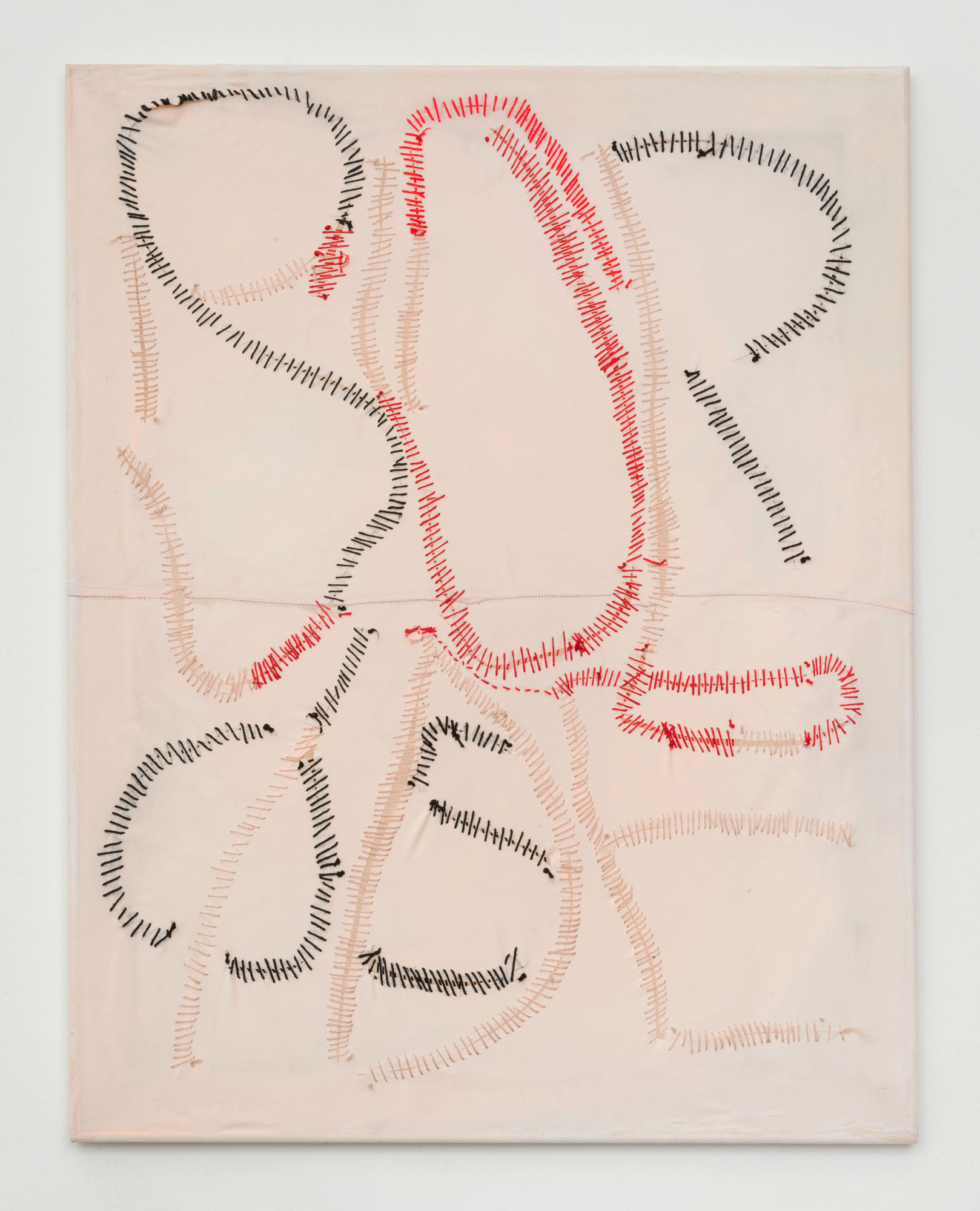Artist: Leda Bourgogne
Exhibition title: DEAD HEAT
Curated by: Cathrin Mayer
Venue: Braunsfelder, Cologne, Germany
Date: February 1 – March 29, 2020
Photography: All images copyright and courtesy of the artist and Braunsfelder, Cologne
The practice of Leda Bourgogne (*1989, in Vienna) is based on the production of paintings, texts and objects. The artist combines found objects as well as handcrafted items through her unconventional working method, which has sur-realistic features. Psychoanalysis, literature as well as strategies of the feminist avant-garde are important references. Bourgogne literally tries to get under the skin of the viewer with her works and makes them one of her most important ref-erences and symbols. She deals with female sexuality and is not afraid to depict the suppressed, the subconscious or the abject. Her works stage the dissolution of the boundaries between intimate and public spaces and at the same time em-phasize the political in the private.
“Dead Heat” combines works conceived and existing especially for the exhibi-tion, which originate from a work context shaped by painting and installation, and draws from the symbolic potential of language, which the two words Dead and Heat hold in store. The term “Dead Heat” comes from the jargon of racing and de-scribes that moment in which the competitors arrive at the finish line at the same time and thus no difference in performance can be detected. The expansive in-stallation can thus be read as a metaphor for a mechanism that has overheated and a damaged social body, in which the symptoms of competitive pressure, fear and aggression come to the surface. It is also about the representation of ambivalences and contradictions, as well as the transformation of states that are located between hyperactivity, apathy and physical discipline.
This ambivalence manifests itself in space through the clash of rubbing aesthetic settings. Fine-meshed fencing is used as an element regulating the gaze and body and transcends to the symbolic moment of self- and external regulation. On the other hand, paintings, objects and drawings are to be found on egg-shell coloured walls, which show the human body in its facets as an organic as well as vulnerable mechanism and as an object of erotic desire. The tension that is creat-ed by the creation of opposites arises in “ Dead Heat” from an interest in aesthetic and formal strategies of delimitation and fragmentation.
This practice is also expressed in the wall objects, which literally transcend and reinterpret the space of classical painting. The artist bleaches, paints, embroiders and cuts opaque, shiny or translucent fabrics stretched on stretcher frames.
The two largest and juxtaposed works “Varix” (2020) and “Bone Machine” (2019) are characterized by protruding, stuffed vaults. The shiny black proliferation in “Varix”, settles against the translucent background and, as a pulsating, filled vein, embodies a state of accumulated pressure that must work its way through. In “Bone Machine” (2019), the protrusions appear as ribs, which “support” the im-age and transform it into a cross. The smaller work “Spook” (2020), freely trans-lated as Spirit, seems to transcend the boundaries of that body. The black vel-vet fabric, stretched and sewn on a stretcher frame, shows a widened seam disappearing inwards, carrying small, beige-coloured shells that seem to swell out of the picture like an indefinable secretion. For Bourgogne, this is about the haunting of a ghost, or more specifically, the representation of painting as a figure that evokes itself. The larger surface of the painting is determined by flame-like, ochre-coloured brushstrokes that show traces or effects of painting with bleach-ing chlorine. The understanding of painting as an indexical imprint of an artistic action also appears in the works, in which language and signs are relevant. In the work “Samsara” (2020), which is translated as Rebirth or Eternal Wandering, different sign systems appear in the form of embroideries on the various surfac-es. Arrows appear here, pointing restlessly in different directions. In the lower area there is a field of embroidered lines, a rhythm of tally marks, lines that are supposedly used in prison as well as in sports and represent a comprehensible temporality. Like a map, this work visualizes a journey on an indefinable route.
Language is not only an important reference system in the paintings, but is also due to the artist’s interest in questioning social conventions that are consolidat-ed through language. Thus, the so-called “Chewing Gum Poems” (continuously) reproduce themselves on the floor of the exhibition space like human cells or speech bubbles and “infect” the rooms in a kind of gentle vandalism, literally orally. The sound work “Punchdrunk” (2019) reproduces the voice of Bourgogne against the background of a rhythmically snapping jump rope. In this immersive work, which tells of a failed love affair, sport and physical discipline appear re-peatedly as relevant themes in the exhibition.
Driven by a desire to understand the contemporary state of body and psyche, “Dead Heat” not only reveals dramatic moments of collision between attraction and repulsion, but also the artist’s sensitivity to nuances and tenderness that reveal fragility and vulnerability for her.
-Cathrin Mayer
Leda Bourgogne (*1989, in Vienna) studied Fine Arts with Judith Hopf at the Städelschule, Frankfurt/Main as well German Philology and Film Studies in Frankfurt and Zürich. Her artistic practice is informed by strategies of painting as well as an ongoing occupation with the body, literature and psychoanalysis. Her latest solo exhibitions include “Dead Heat“, Braunsfelder, Cologne (2020), “In The Feelings Of My Shadow“, Jiri Svestka Gallery, Prague (2019), “Skinless“ BQ Gallery, Berlin (2018) and Kunstverein Braunschweig, (2018). Group exhibitions include Emalin, London (2020, upcoming), “ Kreislaufprobleme “, Croy Nielsen, Vienna (2019), “Dicke Luft“, Galerie Bernhard, Zürich (2019) and “Body and Piec-es“, KAI 10 Athena Foundation, Düsseldorf (2019).










































